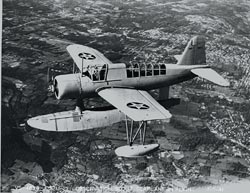|
|||||||
|
One in a Series The old fable about the hare and the tortoise sometimes is re-enacted in wartime — at least it was a couple of times by Vought airplanes in World War II and Korea. The slow Kingfisher was not a fighter airplane despite its 170-mph top speed. But one of them shot down a 350-mph Japanese Zero during Iwo Jima invasion Feb. 16, 1945. The OS2U piloted by Lt (jg) D. W. Gandy tangled with the Zero at 1,500 feet. The Zero dived on the observation airplane, fired a short burst and made a tight right turn. Zeros were highly maneuverable but Gandy zigzagged and came out on the Zero's tail 500 feet astern. He opened up with his single .30 cal. machine gun shooting through his propeller, hitting the Zero's cockpit, engine and wing root. He continued firing and the Zero smoked, burst into flames and crashed on an island bluff. Ground anti-aircraft gunners tried vainly to shoot Gandy down. His victory may be the only time a Kingfisher shot down an enemy airplane in combat, a dubious honor for the Japanese pilot. The other Vought "tortoise" was an F4U-5 Corsair flown by Marine Capt Jesse G. Folmar of VMA-312. The F4U was not slow at 400 mph, but it was a couple of hundred miles slower than the Russian-made Mig-15 jet over Korea. Folmar and his wingman were jumped by four Mig-15s. The second pair of Migs made a pass and went into a climbing left turn. "I turned inside them and gave the nearest one a five-second burst of 20 mm," Folmer said. "The Mig belched smoke and the pilot flew into the air from his ejection seat. His chute opened but it already was on fire." Moments later Folmar's Corsair was shot down by another Mig and he bailed out, landing "in" the" water, where he was rescued by an Air Force Albatross flying boat. His feat took place on Sept. 10, 1952, while Folmar was flying off the Marine carrier Sicily. By downing the Mig, Capt. Folmar won himself a piggy-back ride in a Korean "A" frame on the back of James Barber, Chance Vought Aircraft field service rep. Barber had promised such a ride to the first Corsair pilot to down a Communist jet fighter. More VE-7: Engineering Triumph and War Hero
|

